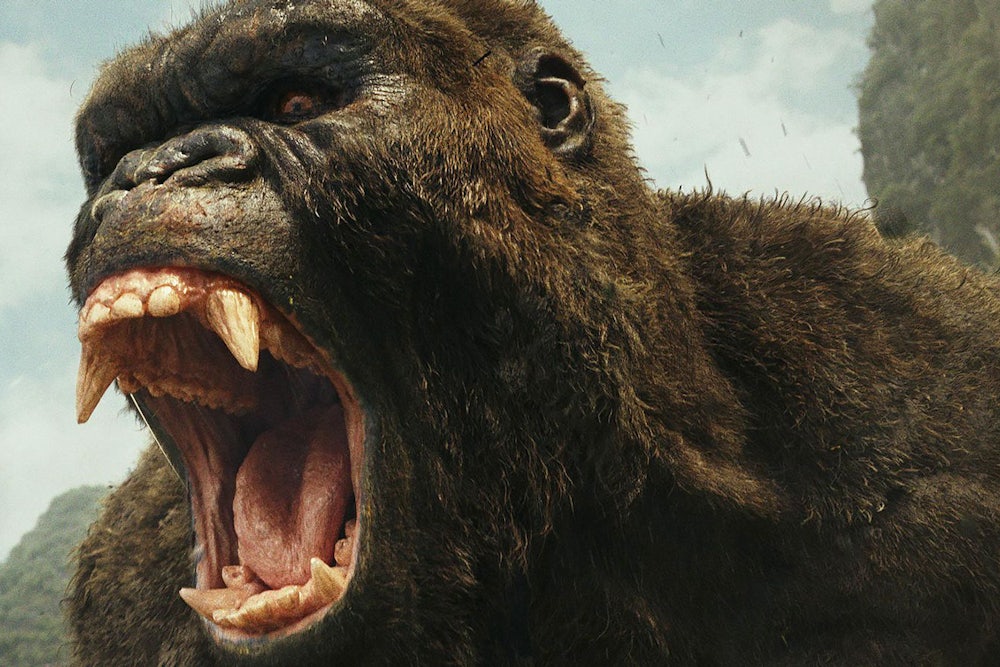A fundamental flaw of any King Kong movie—or maybe it’s a feature rather than a bug—is that the ape is always going to be more interesting than any of the humans who are trying to capture him, kill him, or escape from him. Even in the original film—in which he is wreaking havoc on New York City—he is the noblest of creatures, a protective hero who just wants to be left alone and only strikes when provoked. In every Kong movie, we sympathize with the ape. We ally emotionally only with those humans who are on Kong’s side. Deep down, we secretly want him to crush us all. We sort of have it coming.
So it’s no surprise that Kong: Skull Island has such dull, rote human characters (with one notable, delightful exception). But it is a shock that the ape himself is so distant and sullen. The Kong of Kong: Skull Island doesn’t have the soulful longing of Peter Jackson’s version, who was not only bewildered and lost, but also harbored an obvious (and sort of disturbing!) affection for Naomi Watts’s daffy heroine. This Kong just sort of skulks around Skull Island, fighting monsters when needed, salving wounds from battle, and knocking back the occasional giant squid for sustenance.
Computer technology has advanced enough that Kong looks more realistic than he ever has before. The ape is so anatomically well-rendered that you can’t help but wonder where he’s tucking his Kong penis. But there’s not much behind the eyes this time. King Kong is a quiet, mostly friendly monster who shows up to save our heroes when we need him, then clomps off morosely into the distance when they don’t. This is King Kong! This is one of the most enduring cinematic icons of the last 100 years! Surely he has better things to do than make sure Tom Hiddleston gets to strike some hero poses.
The action in Kong: Skull Island takes place in 1973, in the waning days of the Vietnam War, in a strained metaphor I’m not sure the film has much particular interest in following all that closely. (Setting it during the Vietnam War mostly just allows director Jordan Vogt-Roberts to cloth all his heroes in fatigues and play a lot of Creedence Clearwater Revival on the soundtrack.) Hiddleston is a renowned tracker brought in by the head of a shady government agency (John Goodman) to help a military platoon (led by a just-playing-all-the-hits-you-like Samuel L. Jackson) check out Skull Island, a mysterious place that has never been properly mapped. (They let an “anti-war photographer” played by Brie Larsen come along as well, and it’s a little depressing to see such a fearless, open actress reduced to running around in a tight tanktop for two hours.)
They run into Kong, of course, but also all sorts of other monsters that they need Kong to protect them from. This doesn’t stop Jackson’s increasingly deranged platoon leader from trying to kill the ape anyway, to establish man’s supremacy and to shout Sam Jackson phrases (“Bitch, please!”) at maximum volume and velocity.
At its best, Kong: Skull Island conjures up those adventure tales of old, the Indiana Jones–esque cliffhangers in which Westerners arrive in strange lands and take part in all sorts of derring-do. Skull Island is appropriately odd and scary, with massive bugs attacking from the sky and creatures that you don’t realize look exactly like the massive tree you’re resting your head on until it’s almost too late.
But nothing here that evokes that sensation any better than Peter Jackson’s film did. If anything, Jackson had a deeper love for those swashbucklers than Vogt-Roberts (The Boys of Summer) does, and delved deeper into their lore while still bringing his own unique insanity to the table. The scene in which Jack Black and Adrien Brody fight off a seemingly endless supply of giant insects, a reference to the infamous deleted Spider Pit sequence from the original King Kong, is one of the scariest things I’ve ever seen in a blockbuster, and Kong’s not even a part of it.
Nothing in Kong: Skull Island approaches that, or even attempts to. This film is much more distant and corporate-inclined. The one exception is a World War II veteran played by John C. Reilly, who has been stranded on Skull Island for 30 years and is understandably a bit unhinged by the experience. He provides the movie with some quirkiness it desperately needs, even if it ultimately goes sentimental and sells the character out at the end anyway. This is a movie that puts everybody in the right place, moves them where they need to go, then wraps everything up in time for the sequel. (Which is supposedly going to have Godzilla.)
King Kong is an enduring cinematic figure who has a tendency, for better or worse, to reflect the prevailing societal preoccupations and proclivities of the time. He has been a racist caricature, an embattled warrior, a shamed outcast. Here? He’s just a big brand, Kong Inc., walking around, not thinking much of anything. We all get the King Kongs we deserve, I suppose.
Grade: C+
Grierson & Leitch write about the movies regularly for the New Republic and host a podcast on film. Follow them on Twitter @griersonleitch or visit their site griersonleitch.com.
